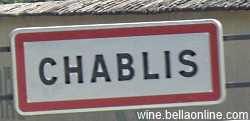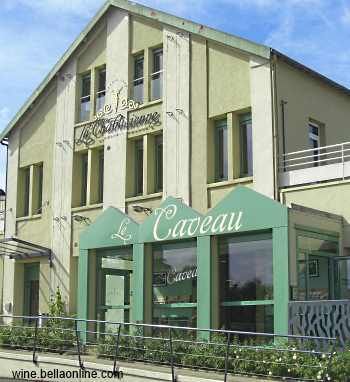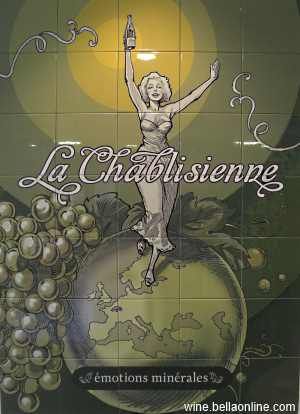Chablis - Chardonnay Personified

Chablis is name that everyone knows, yet few drink it. For a time it even became a generic name that people asked for when they wanted to order a house wine in bar or restaurants.
The wine takes its name from the town of Chablis which is on the banks of the river Serein in a long valley with vines planted on the hills.

Entering Chablis town
Chablis is 135 kilometres (84 miles) north west of Beaune in Burgundy wine region, located roughly midway between Beaune and Paris. We left the A5 motorway to drive across country towards Chablis along narrow straight roads through occasional villages. Fields were dark green with wheat interspersed with mature oak forests.
Cresting the top of the Serein valley we spotted the first vineyards we’d seen since leaving Beaune, their straight rows of bright green unmistakeable in the distance.
Chablis is Chardonnay, and can only be Chardonnay. There are 4,700 hectares (11,600 acres) of vineyards and their location defines their rating. In descending order the four appellations are: Grand Cru (106 ha), Premier Cru (762 ha), Chablis (3126 ha) and lastly Petit Chablis (713 ha) . Grand and Premier Cru vineyards are planted on the valley’s southern facing mid and upper slopes. This far north it is vital to get as much sun exposure as possible which is why southern aspect slopes are prized. What lies under the vineyards also affects classification. All but Petit Chablis vineyards are planted on Kimmeridgian clay, which is limestone formed from ancient shells when this land was a sea bed. Fossils abound in these rocks and this limestone gives Chablis its distinctive minerally flavours. Petit Chablis grows on Portlandian soils, which are geologically younger than Kimmeridgian, and though high in calcium, are lacking shell fossils. These vineyards are found on flatter outlying landsshell fossils. These vineyards are found on flatter outlying lands
Most Chablis see no wood treatment, which results a dry crisp refreshing wine with a greenish tint a world away from New World fat buttery Chardonnay. Some premium Chablis do spend a while in barrel, to add complexity, but the barrels are rarely new or small so their effect is felt subtly in the background.

I visited La Chablisienne winery (above) (www.lachablisienne.com), a co-operative founded in 1923, which now produces 25% of all Chablis wines. Its 300 members farm vineyards in all the Chablis appellations and supply wine to the co-operative which undertakes final vinification then bottles and markets them.
Tasting through a range of their wines from Petit Chablis to Grand Cru I decided I preferred ‘La Sereine’ 2010, one of their four straight Chablis appellation wines, for its purity of fruit, crispness and sheer pleasure in drinking. This comes from twenty different Chablis vineyards and spent a year on its lees in tanks and a small proportion in barrel.
Talk about wine on our forum.
Peter F May is the author of Marilyn Merlot and the Naked Grape: Odd Wines from Around the World which features more than 100 wine labels and the stories behind them, and PINOTAGE: Behind the Legends of South Africa’s Own Wine which tells the story behind the Pinotage wine and grape.
which features more than 100 wine labels and the stories behind them, and PINOTAGE: Behind the Legends of South Africa’s Own Wine which tells the story behind the Pinotage wine and grape.
Disclosure - Peter F May paid in full for his visit, tasting, food and the many wines he brought home.

Wall tiles inside the winery
The wine takes its name from the town of Chablis which is on the banks of the river Serein in a long valley with vines planted on the hills.

Entering Chablis town
Chablis is 135 kilometres (84 miles) north west of Beaune in Burgundy wine region, located roughly midway between Beaune and Paris. We left the A5 motorway to drive across country towards Chablis along narrow straight roads through occasional villages. Fields were dark green with wheat interspersed with mature oak forests.
Cresting the top of the Serein valley we spotted the first vineyards we’d seen since leaving Beaune, their straight rows of bright green unmistakeable in the distance.
Chablis is Chardonnay, and can only be Chardonnay. There are 4,700 hectares (11,600 acres) of vineyards and their location defines their rating. In descending order the four appellations are: Grand Cru (106 ha), Premier Cru (762 ha), Chablis (3126 ha) and lastly Petit Chablis (713 ha) . Grand and Premier Cru vineyards are planted on the valley’s southern facing mid and upper slopes. This far north it is vital to get as much sun exposure as possible which is why southern aspect slopes are prized. What lies under the vineyards also affects classification. All but Petit Chablis vineyards are planted on Kimmeridgian clay, which is limestone formed from ancient shells when this land was a sea bed. Fossils abound in these rocks and this limestone gives Chablis its distinctive minerally flavours. Petit Chablis grows on Portlandian soils, which are geologically younger than Kimmeridgian, and though high in calcium, are lacking shell fossils. These vineyards are found on flatter outlying landsshell fossils. These vineyards are found on flatter outlying lands
Most Chablis see no wood treatment, which results a dry crisp refreshing wine with a greenish tint a world away from New World fat buttery Chardonnay. Some premium Chablis do spend a while in barrel, to add complexity, but the barrels are rarely new or small so their effect is felt subtly in the background.

I visited La Chablisienne winery (above) (www.lachablisienne.com), a co-operative founded in 1923, which now produces 25% of all Chablis wines. Its 300 members farm vineyards in all the Chablis appellations and supply wine to the co-operative which undertakes final vinification then bottles and markets them.
Tasting through a range of their wines from Petit Chablis to Grand Cru I decided I preferred ‘La Sereine’ 2010, one of their four straight Chablis appellation wines, for its purity of fruit, crispness and sheer pleasure in drinking. This comes from twenty different Chablis vineyards and spent a year on its lees in tanks and a small proportion in barrel.
Talk about wine on our forum.
Peter F May is the author of Marilyn Merlot and the Naked Grape: Odd Wines from Around the World
Disclosure - Peter F May paid in full for his visit, tasting, food and the many wines he brought home.

Wall tiles inside the winery
You Should Also Read:
Domaine de la Madone, Fleurie, Beaujolais

Related Articles
Editor's Picks Articles
Top Ten Articles
Previous Features
Site Map
Content copyright © 2023 by Peter F May. All rights reserved.
This content was written by Peter F May. If you wish to use this content in any manner, you need written permission. Contact Peter F May for details.


